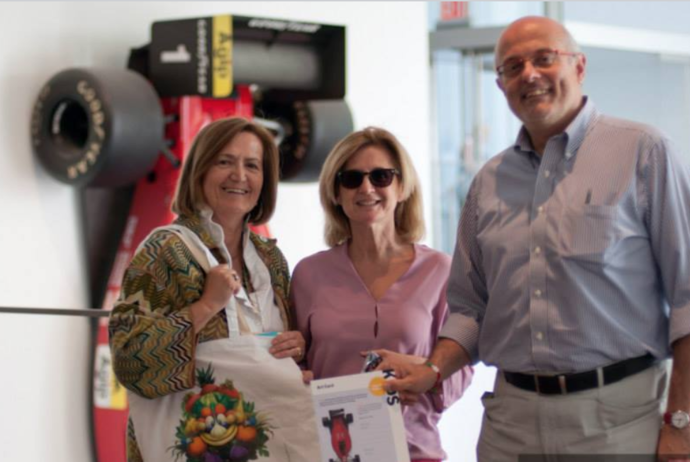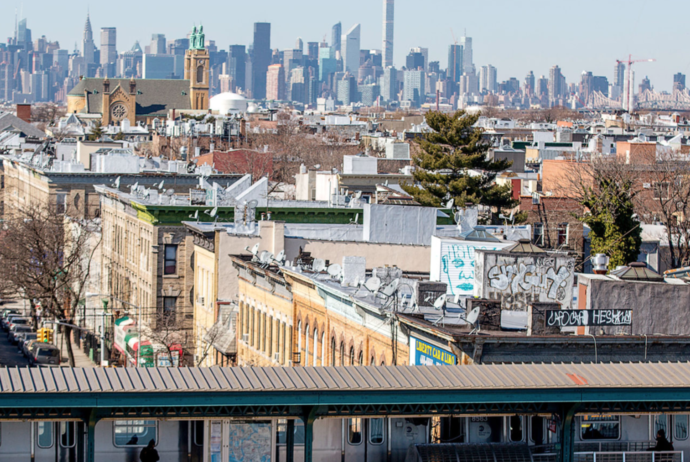BELOW IN ENGLISH
Ambasciatore, prima di tutto grazie veramente a nome di tutti, sono passati 20 anni da quell’11 settembre, come tanti posso dire 'io c’ero2 - abitavo a poche centinaia di metri dalle torri gemelle - ma certo il Console Generale italiano a New York deve aver vissuto intensamente decine di storie di italiani in quei giorni. Un’esperienza unica, molto dura e soprattutto umanamente indimenticabile. Sappiamo che lei ha anche scritto un bel libro intitolato “io c’ero”
Vorrei chiederle di condividere brevemente con noi dei ricordi e delle riflessioni. Perchè lei c’era e con lei c’era tutta l’Italia di New York
Quando ha capito che sarebbe stato un evento molto grave?
Innanzitutto vorrei ringraziarla per l’invito in video che ci permette di ricordare un episodio che rimarrà nella storia del mondo. Quando ho capito che si è trattava di un evento molto grave? Subito, quando vidi il secondo aereo schiantarsi contro le Torri Gemelle io capii che non era un semplice errore di guida o un semplice incidente di percorso aereo, ma che c’era un piano deliberato. Quel momento iniziai subito a prevedere cosa sarebbe potuto succedere e come il Consolato d’Italia avrebbe potuto fornire un’assistenza alle possibili vittime o a chi era stato colpito.
Come si è organizzato il Consolato e quali sono stati i passi più importanti che ha dovuto fare?
Il primo passo è stato mettersi subito in contatto con il Ministero degli Esteri, che a sua volta mi mise in contatto con il sistema diciamo di vigilanza che opera 24 ore su 24. E cominciammo già a scambiarci delle impressioni in tempo reale. Quello che io vedevo in televisione e quello che mi cominciava ad arrivare al telefono costituiva oggetto di in uno scambio di idee continuo con i miei interlocutori al Ministero degli Esteri.
Tanto lavoro in Consolato con il personale che ancora ringraziamo, perché sono stati eccezionali, ma anche tanto lavoro nella comunità italiana e nella comunità italo-americana. La presenza degli italo-americani presso le istituzioni, presso le forze dell’ordine, i vigili del fuoco è stata fondamentale.
Esattamente e questo mi consente di continuare quello che avevo detto prima. Una volta stabilito questo contatto con gli headquarters, dovevo subito stabilire il contatto con i vari uffici del consolato che potevano essere coinvolti e soprattutto con la comunità, le associazion,i che subito pensai potevano costituire un punto di riferimento per la nostra assistenza. E poi subito il contatto con le autorità locali fu molto difficile perché, come poi si è saputo, gli uffici del sindaco e del governatore ricevettero tante tali chiamate da tutto il paese che decisero di non comunicare con le autorità consolari locali, proprio in previsione di richieste di assistenza. Dunque ci fu un blackout. Dovetti allora ricorrere all’assistenza preziosa della mia segretaria Lisa che non scorderò mai. E’ sempre stata un punto di riferimento per tutti i connazionali e chiesi a lei di entrare in contatto con questi interlocutori, ma non per le vie ufficiali. Chiamiamole vie sotterranee, io ci dovevo arrivare. Devo dire che con grande sforzo riuscii ad avviare un canale per avere delle notizie di prima mano che mi permettevano di orientarmi e soprattutto di fornire informazioni a Roma che poi doveva dare delle istruzioni.
Quando ha realizzato che erano coinvolti tanti italiani e soprattutto tanti italo-americani. Quando ne ha avuto la percezione della gravità da questo punto di vista?
Questo è stato un altro problema grosso. Stabilire in tempi rapidi quante persone potevano essere oggetto di aiuto, tenuto conto anche delle centinaia e centinaia di telefonate, il Consolato ricevette in 10/15 minuti qualcosa come 4000 chiamate. Cercai di fare calcoli sovrastimati, molto meglio sovrastimare che sottostimare. Calcolai 2000 3000 persone che potevano lavorare, visitare, essere coinvolte. Cominciai a parlare con le persone delle associazioni e chiesi questo dato secondo voi è giusto? Vi risulta? Non c’è niente da fare. Non si poteva fare da soli. Occorreva una collaborazione globale. Io devo dire che l’ottenni. Poi sorse il problema: quelli di cittadinanza o quelli di origine, gli italiani con il passaporto o senza? Era uno pseudo problema. Si trattava di salvare vite umane!
Vorrei da lei, a livello personale, considerando anche gli eventi delle ultime settimane, un commento, una riflessione oppure il ricordo di un’immagine che le viene in mente, soprattutto in questo periodo se pensa a quei giorni…
Ci sono due cose. Primo la scena che più mi impressionò fu la caduta della prima e del seconda torre, fu terrificante, mi rimarrà sempre impresso nella mente. Il secondo è la forza morale delle autorità e di tutta la popolazione di New York, forza morale che fece pronunciare all’allora sindaco Giuliani questa frase che io ho poi stampato nel mio libro: "Abbiamo fatto del giorno più scuro il giorno più luminoso".
Mi lasci un attimo per mandare un caro saluto a tutti gli italiani d’america che ho nel cuore e soprattutto a tutte le nuove generazioni che dovrebbero trovare ispirazione in quello che quegli italiani hanno fatto, i loro genitori, per rendere non soltanto la comunità italiana all’estero ma l’America grande.
------
Ambassador, first of all thank you so much on behalf of everyone. 20 years have passed since that September 11th. Like many, I can say I was there - I lived a few hundred meters from the Twin Towers - but certainly the Consul General of Italy in New York must have seen dozens of Italian stories in those days. A unique experience, very hard and above all unforgettable. You have also written a book called "September 11. I was there" I would like to ask you to briefly share your memories and reflections. Because you were there and with you was the whole ‘Italy of New York’. When did you realize it was going to be very, very serious?
First of all, I would like to thank you for this invitation that allows me to remember an episode that will remain in the history of the world.
When did I realize it was a very serious event? Immediately when I saw the second plane crash into the Twin Towers, I realized that it was not a simple driving error or a simple plane crash, but a deliberate attack. I immediately began to figure how the Consulate of Italy could provide assistance to possible victims.
How was the Consulate organized and what were the most important steps it had to take?
The first step was to immediately get in touch with the Foreign Ministry which in turn put me in contact with the surveillance system, let's say, which operates 24 hours a day. And we already began to exchange impressions in real time. What I saw on television and what was beginning to arrive on the phone was the subject of a continuous exchange of ideas with my interlocutors at the Foreign Ministry.
There was a lot of work for the Consulate, I’d like to thank once again all the staff, they have been exceptional.
But there was a lot of work for the Italian community too, and the Italian-American community. The Italian-Americans serving in the city institutions, the police, the firefighters were fundamental.
Exactly. Once the contact was established with the headquarters, I immediately contacted the various Consulate offices that could be involved and above all the community, the associations that I immediately figured could be a point of reference.
Then I tried to be in touch with the local authorities, which was very difficult because the offices of the Mayor and the Governor received so many such calls from all over the country that they decided not to communicate with foreign consular authorities precisely in anticipation of all the requests for assistance that could emerge.
So there was a blackout. Here I resorted to the invaluable assistance of my secretary, Lisa, whom I will never forget. She has always been a point of reference for the Italian American community and I asked her to get in touch with them, but not through official channels. Let's call it ‘underground channels’, I had to get there somehow.
I must say that, with great effort, I was able to open a channel to get first-hand news that allowed me to determine what to do and above all to provide information to Rome.
When did you realize that so many Italians and above all so many Italian Americans were involved?
This was another big problem. Establishing quickly how many people could be needing help, also taking into account the hundreds and hundreds of phone calls ... the Consulate received something like 4000 calls in 10/15 minutes. ...
I tried to overestimate, much better to overestimate than underestimate. I calculated that 2000 to 3000 people could be involved, between employees and visitors.
I started talking to the Italian associations and asked about this estimate, “Do you think it is right? Do you agree?”
No way you could do it alone! Global collaboration was needed. And I got it. And then the problem arose: must we help only Italian citizens? Or also all the Italian descendants? Just those holding an Italian passport, or everyone? It was a pseudo problem. It was about saving lives!
I would like to ask you, on a personal level, a comment, a memory that comes to mind when you think about those days...
There are two things. First, the scene that most impressed me was the fall of the first and second towers, it was terrifying, it will always remain imprinted in my mind.
The second is the moral strength of the authorities and of the entire population of New York, a moral strength that made the then mayor Giuliani pronounce this sentence that I then printed in my book:
“We made the darkest day the brightest day.”
Let me send a warm greeting to all the Italians of America, they’re all in my heart. And above all to the new generations, who should find inspiration in what those Italians have done, their ‘parents’, to make the Italian community abroad great -- actually to make America great!





































